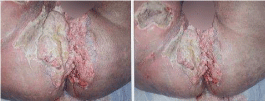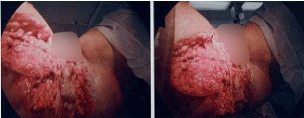Abstract
Background: Fournier gangrene (FG) is a necrotizing fasciitis of the perianal and genitourinary area. It’s a rare disease in women. It has an incidence of 1.6/100,000 in male population. It is most often found in men between the ages of 50 and 60 with a reported incidence of 1.6 cases per 100,000 males.
Case Report: A 36-year-old female with, history of HPV, sexual worker since her 20’s and poor medical compliance presented to the emergency department due to fatigue of 1 week duration. Physical exam was positive for abscess with subcutaneous emphysema in the external genitalia and her hemoglobin was 2.4g/l; WBC 64.3×103/L. Patient was transfused and transferred to ICU. A pelvic CT showed a mass like thickening with subcutaneous emphysema in the perineal area. The diagnosis of FG was done. She received broad-spectrum antibiotics and was transferred to the OR for debridement. During surgery an anal mass was found which was positive for squamous cell carcinoma. Patient initially refused medical attention. A Clinical psychologist who successfully used the BATHE questionnaire diagnosed an adjustment disorder. She accepted to be treated and after 41 days was finally discharged with follow-up by primary care, psychologist and oncologist.
Conclusion: FG has an impact in both the physical and mental health of a patient and need a long-term primary care follow-up to decrease its morbidity and increase the patient quality of life. Our patient had a strong risk factor for developing anal and cervical squamous cell carcinoma. She was HPV positive since her 20’s but avoided proper treatment and follow up. It is important to recognize that the risk of HPV infection is highest among those who are newly sexually active, and that the risk decreases with age. The intervention and collaboration with the psychologist in our case was essential. The BATHE questionnaire applied is a strategy structured set of questions and statements created specifically for the primary care setting and its inherent time constraints to address a range of psychosocial problems.
Keywords: Fournier's gangrene; Squamous cell carcinoma; BATHE questionnaire; HPV
Abbreviations
FG: Fournier Gangrene
Introduction
Fournier's gangrene is a rare and life-threatening infection caused by aerobic and/or anaerobic microorganisms that synergistically affect subcutaneous tissue and fascia with microcirculation thrombosis, and consequently, rapidly progressive necrosis of the skin in the affected region [1]. It is most often found in men between the ages of 50 and 60 with a reported incidence of 1.6 cases per 100,000 males [2]. The dramatic course of this medical condition is a stressor that can trigger a mental condition such as Adjustment disorder (AD) which is a maladaptive reaction to an identifiable psychosocial stressor or multiple stressors that usually emerges within a month after the onset of the stressor [3].
Case Presentation
Herein we report a 36-year-old female with, positive HPV, sexual worker since her early 20’s, illicit drug user with poor medical compliance, who presented to the emergency department with a history of fatigue and general weakness since 7 days prior to admission. Physical examination demonstrated that she was pale, had tachycardia (139beats/min) and hypotension (90/60mmHg). Her appearance suggested a depression mood without eye contact and she refused several times to cooperate in her physical exam. At her physical she was alert, awake, and in acute distress. Lungs and heart were unremarkable. She had a right thigh and right vulvar abscess and subcutaneous emphysema. A CBC showed an Hg 2.4g/dl; HTC 8.7g/dl; WBC 64.3×103/l; CPR 29.800mg/dl. She was transferred to intensive care unit for eight days and Red blood products were transfused. The patient admitted that she never returned for follow up with her primary care physician regarding her HPV diagnosis, because she was not interested in further management at that moment even after several intervention, she also mentioned that abscesses in the thing and genital area has been present since 2 days go but felt embarrassed to show it to her primary care physician. After her hemodynamic stabilization a pelvic CT scan was done and shows a mass like thickening and enhancement with subcutaneous emphysema in the perineal area (Image 1). The patient was started on Vancomycin 1500mg every 12 hours, Clindamycin 900mg every 8 hours, Piperacilin/Tazobactam 3.375g every 8 hours and surgical intervention was needed for incision, drainage and debridement, but the patient refused any further management. At that moment her mood was labile. She cooperated poorly and mixed anxietydepression and conduct disturbance was identified. She was consult with a Clinical psychologist who used the BATHE (background, affect, troubles, handling, and empathy) questionnaire and diagnosed an adjustment disorder. After several sessions with the psychologist the patient decided to go to the operating room (Image 2). The abscess was cultured and was positive Morganella morganii, Pseudomona aeuriginosa, Escherichia coli, Enterococcus faecalis, an anal mass was found and biopsied resulting positive for squamous cell carcinoma. The patient continued on intravenous antibiotics until the laboratory results arrived within the normal range and she was stable. After 41 days of admission she was discharged home with follow up by primary care physician to continue antibiotic treatment, Oncologist due to her anal cancer and by the psychologist.
Discussion
FG is a serious medical condition with high mortality and morbidity [5]. It occurs predominantly in male, but has been described in female and children [5]. FG is commonly a polymicrobial infection of genitourinary or perianal source. However, the portal of entry is often difficult to establish. Microbial invasion usually occurs either through direct injury or through a direct spread from urogenital organs or a perforated visceral like the colon, rectum, or anus [6].
Early and aggressive surgical debridement of necrotic tissue is the key to limit the spread and metabolic consequences of a gangrenous infection [6]. Empirical broad-spectrum antibiotic therapy (penicillin, metronidazole and third-generation cephalosporin with gentamicin) should be initiated before surgical treatment and changed according to the culture findings. Surgical debridement should entail wide excision of the necrotic tissue and should be repeated as the necrosis progresses [6]. The patient’s usually poor general condition, inadequate fluid resuscitation, the need for strict monitoring, proper and frequent wound dressing and repeated wide debridement are factors that usually qualify the patient to be treated in the intensive care unit.
Our patient had a strong risk factor for developing anal and cervical squamous cell carcinoma. She was HPV positive since her 20’s but avoided proper treatment and follow up. It is important to recognize that the risk of HPV infection is highest among those who are newly sexually active, and that the risk decreases with age. The peak incidence of high-risk HPV infection is in teenagers and in women in their early 20s. Current guidelines recommend women 30- year-old or older to undergo pap's smear every 5 years with HPV testing if came negative [7]. When a patient has a positive result for the HPV testing there are two options: if it's positive for one of the 12 high-risk types, the next step is cytology, and if it's positive for highrisk type 16 or 18, the next step is a colposcopy [7].
The preventive intervention of primary physician was essential to avoid this medical condition. Teenage patients have to be educated about sexually transmitted disease and the importance of following up continuously in case of contracting any of them. Early and proper management of HPV virus infection decrease the probabilities of developing anal or cervical cancer and diminishes the likelihood of developing life-threatening disease like FG.
The intervention and collaboration with the psychologist in our case was essential. The BATHE questionnaire applied is a strategy structured set of questions and statements created specifically for the primary care setting and its inherent time constraints to address a range of psychosocial problems [4]. The psychological support is also necessary to overcome the loss and disfigurement of the genitals. In this case, the patient was diagnosed with an adjustment disorder and was given continued follow up with the PCP, psychologist and her family in order to face the diagnosis of anal cancer, and the new physical changes and adjustment disorder can lead to a major depressive disorder and patients lacking psychological intervention or good family support run the risk of further morbidity, including the possibility of suicide.

Figure 1: Genital and perianal area showing the Fournier’s Gangrene.

Figure 2: Genital and perianal area after incision, drainage and debridement.
Declarations
The editors and reviewers of this article have not received any financial funding for the case report.
The authors have the consent to write the case report.
References
- Filhoa Nivaldo, Patriotaa Gyoguevara, Falcão Rodrigo. Treatment of Fournier's gangrene of the shoulder girdle. Revista Brasileira de Ortopedia (English Edition). 2018; 53: 493-498.
- Frank JB. Adjustment Disorders. 2016.
- Mathew D. Sorensen, John N. Krieger, Frederick P. Rivara. Fournier’s Gangrene: Population Based Epidemiology and Outcomes. J Urol. 2009; 181: 2120–2126.
- Searight Russell. Counseling Patients in Primary Care: Evidence-Based Am Fam Physician. 2018; 98: 719-728.
- Stevens Dennis L, Baddour Larry M. Necrotizing soft tissue infections. 2019.
- Rechura Caitlyn M, Caro Rebecca. Cervical Cancer Screening. Am Fam Physician. 2018; 97: 441-448.
- Thwaini A, Khan A, Malik A. Fournier's gangrene and its emergency management. Postgrad Med J. 2006; 82: 516–519.
